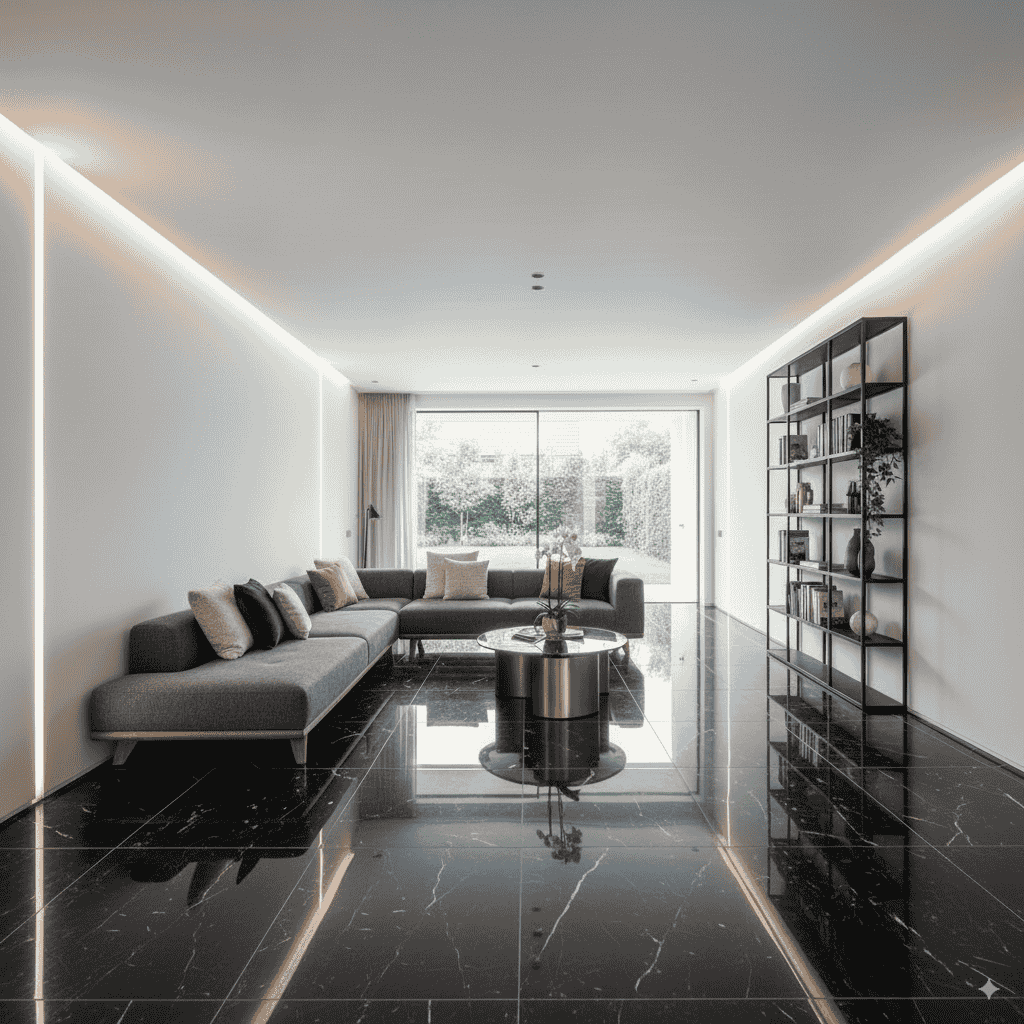Black tiles often raise the question of whether they are too bold for a space. In practice, black tiles can create a sleek, modern, and timeless look. The deep color adds depth and contrast that lighter shades cannot achieve. Bathrooms, kitchens, living rooms, and even outdoor patios benefit from the bold impact of black tiles.
This guide covers every detail: what black tiles are, the materials they come in, the finishes available, and where they work best. It also explains care tips, cost ranges, and design ideas. By the end, the complete picture of how to use black tiles in any space and budget will be clear.
What Are Black Tiles?
Black tiles are surface coverings used for floors, walls, and outdoor areas. They are made from different materials and cut into various shapes and sizes. Their strong color delivers elegance and helps other design elements stand out.
Common Materials
-
Porcelain: Dense, durable, and resistant to water; often used in bathrooms and kitchens.
-
Ceramic: Affordable and light, ideal for walls and low-traffic areas.
-
Marble: Luxurious and natural, with unique veining patterns that suit upscale interiors.
-
Granite: Hard and long-lasting, perfect for high-traffic floors and outdoor zones.
-
Slate: Textured and earthy, providing grip in wet areas.
-
Terrazzo: A mix of stone chips and cement, offering a stylish speckled appearance.
-
Glass: Reflective and bright, common in backsplashes and mosaics.
Key Attributes
When choosing black tiles, several attributes guide the decision:
-
Finish: Glossy, matte, honed, or textured, each affecting light reflection and ease of cleaning.
-
Size: Options range from small mosaics to large slabs, influencing grout visibility.
-
Thickness: Standard thickness is 8–12 mm, with thicker slabs available.
-
Edge: Rectified edges allow tighter grout lines and a seamless look.
-
Slip Resistance: Rated R9 to R13, with higher ratings offering safer performance in wet zones.
-
Durability: Measured by PEI (Porcelain Enamel Institute) ratings and MOHS hardness.
-
Absorption: A critical factor in bathrooms and outdoor spaces; lower absorption means better water resistance.
Comparison at a Glance
Here is a quick overview of the main black tile materials:
|
Material |
Water Absorption |
Durability (PEI/MOHS) |
Typical Sizes |
Finish Options |
Best Use Cases |
|
Porcelain |
≤0.5% |
PEI 4–5 / MOHS 7–8 |
300×600, 600×600, 600×1200 |
Glossy, Matte, Textured |
Bathrooms, Kitchens, Floors, Outdoors |
|
Ceramic |
3–7% |
PEI 3–4 / MOHS 5–6 |
150×150, 300×600 |
Glossy, Matte |
Walls, Low-Traffic Floors |
|
Marble |
0.1–0.2% |
MOHS 3–5 |
Slabs, 600×600 |
Polished, Honed |
Luxury Floors, Walls, Bathrooms |
|
Granite |
0.1–0.5% |
MOHS 6–7 |
300×300, 600×600 |
Polished, Textured |
High-Traffic Floors, Outdoor Patios |
|
Slate |
0.5–1% |
MOHS 5–6 |
300×300, 400×400 |
Natural, Textured |
Bathrooms, Outdoor, Rustic Spaces |
Where Black Tiles Work Best
Black tiles work in many rooms, but the key is to match the right tile with the right setting. Each space has its own needs.
-
Bathrooms
Bathrooms often look striking with black tiles. Floors in matte or textured finishes reduce slips, while walls shine with polished stone or glossy porcelain. Small mosaics also help with grip in shower floors. Paired with bright light, black tiles can turn a plain bathroom into a calm, stylish retreat.
-
Kitchens
Kitchens gain instant impact from black tiles. A glossy black splashback creates contrast with pale cabinets. Porcelain floors stand up to spills and daily wear. For a more creative look, I like to use black tiles with metallic trims or mix them with lighter tones for balance.
-
Living Rooms and Feature Walls
In living rooms, black tiles add drama. A large tiled wall in marble or slate becomes a bold centerpiece. Large-format tiles cut down grout lines and give the space a smooth, seamless feel. Used with soft lighting, black tiles make the room feel warm as well as modern.
-
Outdoor Spaces
Outdoors, black tiles need to be tough and safe. Granite and slate are the best choices here. They resist frost and weather changes. Textured surfaces help prevent slips near pools or on patios. When laid with the right slope for water to drain, they stay practical as well as stylish.
Finishes and Formats
The finish and shape of black tiles change the look and feel of a room. Each choice affects shine, grip, and style.
-
Glossy vs Matte
Glossy tiles reflect light and add sparkle to walls and splashbacks. They can make a room feel brighter. Matte tiles hide streaks and water marks, which makes them better for floors in wet areas.
-
Textured and Anti-Slip
Textured black tiles provide grip. They are the safest option for bathrooms, wet rooms, and pool surrounds.
-
Large Format
Large tiles cover more space with fewer joints. They make rooms feel bigger and give a clean, modern look.
-
Subway Tiles
Subway tiles are a timeless style. In black, they give a crisp, bold finish to kitchens and bathrooms. Stacked in rows or laid in a brick pattern, they always stand out.
-
Hexagon and Herringbone
Hexagon shapes bring a modern edge, while herringbone layouts add movement. Both styles work well as feature walls or patterned floors.
-
Mosaic
Mosaic tiles are small but versatile. They curve around tricky spaces and add detail to showers and splashbacks. Used in borders, they also frame larger tiles with style.
Costs and Buying Tips
The price of black tiles varies by material, size, and finish.
Material and Price Range
-Porcelain usually costs between £30 and £80 per square metre.
-Ceramic is cheaper, often £10 to £40 per square metre.
-Marble starts at £80 and can run well over £150 per square metre.
-Granite falls between £60 and £100 per square metre.
-Slate costs £40 to £70 per square metre.
-Glass tiles are priced around £60 to £120 per square metre.
Installation Costs
Fitting costs also matter. Large slabs need more care and levelling systems, which raise labour charges. Small mosaics take longer to set, which adds to the price. A well-prepared base is key, and any extra cuts or trims add time and cost.
Sample Testing
Always order samples before you buy. Place them in the room at different times of the day. Warm light at 2700K softens the tone, while cool light at 4000K sharpens it. Testing this way shows how the tile will look once installed.
Installation, Grout and Maintenance
Good tiles still need the right fitting and care. Getting these steps right makes black tiles last longer and look better.
Grout Colour Choices
The grout colour changes the whole look. Black grout blends with the tile and hides dirt. Dark grey softens the contrast but still keeps a clean look. White grout adds drama but needs more cleaning to stay bright. I suggest testing a small area with two or three grout colours before making a final choice.
Cleaning Without Streaks
Black tiles show water spots and streaks more than light tiles. A simple routine works best. Warm water, a mild cleaner, and a soft cloth are all you need. For glossy finishes, a quick wipe with a microfibre cloth stops streaks. Matte and textured tiles hide marks better but still need regular cleaning.
Common Mistakes
Some mistakes are easy to avoid. Laying tiles without a level base causes uneven joints. Using the wrong sealer on marble or slate can stain the surface. Outdoor tiles need a slope for drainage; without it, water pools and makes them unsafe. Paying attention to these details saves time and money later.
Design Inspiration and Pairings
Black tiles work with many styles. The key is balance.
Minimalist, Industrial, and Luxury Looks
In a minimalist space, black tiles act as a sharp backdrop for clean lines. Industrial rooms mix them with exposed brick, steel, or concrete. For a luxury finish, polished black marble adds depth and shine.
Colour Pairings
Black tiles look striking with white for a classic monochrome style. Paired with warm wood tones, they feel more natural. Mixed with gold or brass fittings, they give a rich, elegant look.
Lighting Design for Black Surfaces
Lighting makes a big difference. Warm light around 2700K softens the feel of black tiles. Cool light near 4000K makes them crisp and modern. I always test with both before choosing the final setup.
Frequently Asked Questions
Are black tiles hard to keep clean?
Not if you choose the right finish. Matte hides marks better. Glossy tiles need a quick wipe now and then.
Glossy vs matte black tiles: which is better for bathrooms?
Glossy tiles are fine on walls but matte or textured finishes are safer for floors.
Do black floor tiles make rooms look smaller?
They can, but using large-format tiles and good lighting keeps the space open.
What grout colour should I use with black tiles?
Black hides stains, grey softens the look, and white adds bold contrast. The choice depends on style and upkeep.
Are black tiles slippery?
It depends on the finish. Check the R-rating. Higher numbers mean safer grip in wet areas.

